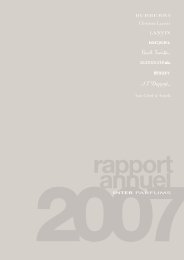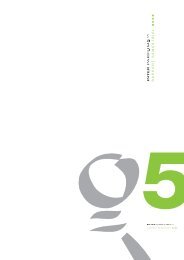2006 - Interparfums
2006 - Interparfums
2006 - Interparfums
You also want an ePaper? Increase the reach of your titles
YUMPU automatically turns print PDFs into web optimized ePapers that Google loves.
control to obtain a description of the internal control system<br />
by sending managers a sample of entities selected according<br />
to the degree of risk they generate for the company when<br />
they have an impact on the company's financial statements,<br />
a self-assessment questionnaire to measure the application<br />
of internal controls on the basis of voluntary statements.<br />
If processes and the associated controls are not formalized or<br />
are considered insufficient a remediation plan is implemented<br />
by the manager concerned to complete the existing system<br />
of internal controls.<br />
This concerns entities involved in the following processes:<br />
■ the management of orders and their settlement,<br />
■ the management of trade payables,<br />
■ inventory management,<br />
■ marketing budget management,<br />
■ the management of royalties,<br />
■ monitoring currency hedges,<br />
■ monetary compliance with social security,<br />
and tax obligations,<br />
■ account cut-offs,<br />
■ information system management.<br />
On the basis of these questionnaires, the company analyses<br />
the description provided and conducts a review of risk areas<br />
not yet identified.<br />
These risk areas are identified when internal control<br />
procedures for processes are implemented and for which key<br />
controls are developed to provide an accurate map of risks.<br />
This undertaking is part of an ongoing proactive and<br />
preventive approach both at the level of Inter Parfums S.A.<br />
and the Group. This work has led to the creation of a strategy<br />
for conducting tests in the principal areas concerned.<br />
Every year, after updating all company procedures and<br />
identifying, when applicable, new risk areas, the company<br />
implements a program of tests and analysis for the year<br />
in progress and repeats all tests again. In addition to the<br />
assistance by the consulting firm Ernst and Young,<br />
the company has implemented an organization destined<br />
to ensure the independence and objectivity of company<br />
personnel when conducting these tests. After the different<br />
phases of analysis and tests have been completed,<br />
Ernst & Young issues a report summarizing control issues<br />
and highlighting eventual dysfunctions or potential<br />
dysfunctions that could result from inadequate controls.<br />
This report contributes to increased accountability by all<br />
parties involved in internal control procedures. It may be<br />
accompanied by a remediation plan to complete and refine<br />
existing internal controls and when necessary an action plan<br />
to formalize, harmonize and improve internal control<br />
procedures for greater effectiveness.<br />
Assessments of these different tests are transmitted<br />
to the Finance Department that issues an opinion concerning<br />
weaknesses that may have been identified and more<br />
generally on the quality of internal control.<br />
4.<br />
Tests of internal control procedures<br />
conducted in <strong>2006</strong><br />
In November <strong>2006</strong>, based on information available to it and<br />
after consultation with the different concerned management,<br />
the company updated and finalized all its manuals of internal<br />
procedures.<br />
It then identified potential risk areas and adapted in<br />
consequence the control procedures. Similarly, it reviewed<br />
existing key controls to ensure that they adequately<br />
addressed the map of risks that was produced.<br />
It was able to validate all internal control procedures.<br />
Particular attention was focused on the volume and quality<br />
of the sampling according to the following breakdown.<br />
The 92 controls performed based on 77 risks areas<br />
concerned the following operating entities:<br />
■ sales, 9 controls,<br />
■ purchasing, 12 controls,<br />
■ stocks, 9 controls,<br />
■ royalties, 2 controls,<br />
■ marketing / Advertising, 4 controls,<br />
■ payroll, 15 controls,<br />
■ taxes and equivalent, 5 controls,<br />
■ fixed assets, 6 controls,<br />
■ cash management, 11 controls,<br />
■ information systems, 6 controls,<br />
■ account cut-offs processes, 13 controls.<br />
The result of these tests did not indicate any significant<br />
control deficiencies.<br />
5.<br />
Forecasted trends for 2007<br />
The company assures permanent oversight of organizational<br />
changes to anticipate, adapt and optimize internal control<br />
procedures in real time. Its internal control procedures are<br />
also designed to respond to both regulatory requirements<br />
and future issues facing the company.<br />
In <strong>2006</strong>, a supply-chain planning system was implemented<br />
to optimize inventory management and production processes<br />
and sourcing from suppliers. This tool will be operational<br />
in 2007.<br />
In addition, starting in 2007 internal control procedures<br />
will be extended to new European subsidiaries included<br />
in the Group organization.<br />
In line with this focus on ongoing improvements in internal<br />
controls, the company will continue to set new priorities<br />
with the following objectives:<br />
■ pursue the formalization of procedures,<br />
■ strengthen controls over operating and administrative<br />
entities within the framework of remediation plans,<br />
■ extend testing to new internal control processes,<br />
■ quality financial information and effective management<br />
of the principal risks and monitoring regulatory requirements.<br />
55











